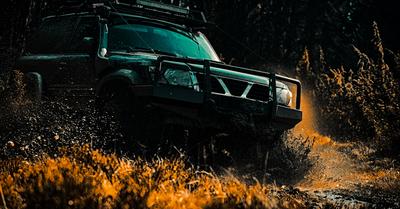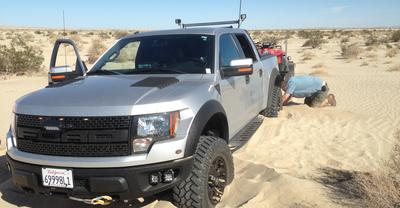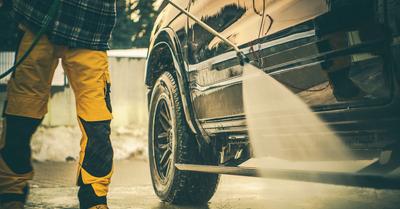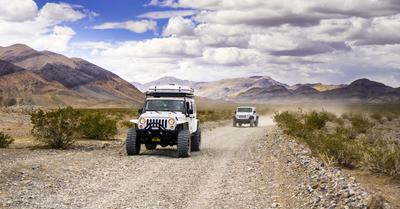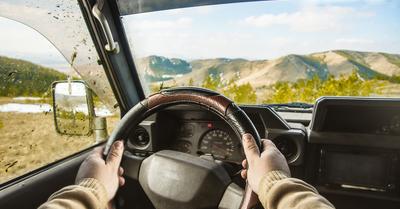For the adventurous souls who crave adrenaline, off-roading is a pursuit that promises immense thrill and satisfaction. But how do you off-road a vehicle?
To off-road a vehicle, you need to equip your vehicle properly, learn about key off-roading features like approach, departure, and break-over angles, find a place to go off-roading, learn the rules of the area, and practice a lot. Always avoid oversteering when off-roading too.
Off-roading demands a certain level of knowledge, skills, and respect for the environment. In this guide, I will explain and introduce essential tips for beginners on how to off-road a vehicle safely and effectively. Buckle up, and let's embark on this adventurous journey together.
Key Takeaways
- To off-road a vehicle, choose your vehicle, upgrade your vehicle, learn about key off-roading vehicle features, bring safety equipment, find a place to go off-roading, and learn about local rules and laws.
- To be more successful while off-roading with a vehicle, be ready for “whip,” avoid oversteering, use left foot braking and air down the tire pressure.
- Off-roading can be dangerous without the right recommended vehicle and safety equipment.
This article may contain affiliate links where we earn a commission from qualifying purchases.
How To Off Road A Vehicle: Essential Tips for Beginners
Off-roading is an intense, exhilarating experience that becomes more existing as you gain more experience. Consider finding an off-road vehicle with four-wheel drive to handle these conditions.
Whether tackling muddy trails, traversing rocky paths, or navigating sand dunes, off-roading offers a unique and exciting way to see the world beyond the pavement. Here’s the approach I would take.
Choose The Right Vehicle
Not all vehicles are created equal, and this is especially true when it comes to off-roading. The right vehicle depends on the type of terrain you'll be traversing. Vehicles with high ground clearance, 4-wheel drive, and good suspension are typically best.
Some popular options include Jeeps, Land Rovers, and certain models of trucks and SUVs. If you're serious about off-roading, you might consider investing in a vehicle specifically designed for this purpose.
Upgrade Your Vehicle
Upgrading your vehicle is essential for successful off-roading adventures. Start by investing in a set of purpose-built tires with a deep tread to maintain a grip on mud, rocks, and other challenging terrains.
Installing a strong suspension system, choosing the right lift kit, and undercarriage protection are also critical for effective off-roading. Also, understand the limitations of your vehicle, including its ground clearance, approach and departure angles, and wading depth.
Knowing what your vehicle can and cannot do will help prevent getting stuck or damaging your vehicle. If you know the limits, you can adequately upgrade it for trail driving, dirt roads, and other terrain types to maintain traction.
Learn About Key Off-Roading Vehicle Features
Understand your vehicle's unique features, such as the approach, departure, and break-over angle. These angles help determine your vehicle's ability to clear obstacles on uneven and rocky trails.
Familiarize yourself with the 4WD system, differential locks, and traction control, and know how and when to use them. Generally, longer off-road vehicles will have worse break-over angles, affecting approach and departure angles too.
Consider adding all-terrain tires to help with rock crawling and exploring an off-the-beaten-path. If your off-roading adventures take you into sand dunes, these tires will help too.
Bring Safety Gear & Special Equipment
Be prepared with essential equipment, such as front and rear recovery points (tow hooks or D-ring shackles), a tow strap, a roll bar/cage, a jack, a fire extinguisher, and a basic toolset.
These items improve your safety and can help you out if your vehicle gets stuck in tricky terrain. Always pack a spare tire and a first aid kit whenever driving off-road to prepare for the worst.
Find A Place To Off-Road
Seek out legal and designated off-road parks or trails in your region. Consult fellow off-roaders, and join social media groups and local clubs to learn about popular locations, trail difficulties, and current conditions.
This way, you can tailor your off-roading experience to suit your skill level. Make sure any trail you choose is large enough for your vehicle. You need more space in a car or truck than off-roaders on dirt bikes do.
Learn The Rules Of The Area
Familiarize yourself with the rules and regulations of the off-road region you choose. Some trails may have specific requirements for vehicle modifications, safety gear, and trail permits.
Respecting the local guidelines will help ensure a smooth and enjoyable off-roading experience. You should also learn about the state laws surrounding an off-highway vehicle to ensure you have the proper permits to become an off-roader.
Practice, Practice, And Practice More
The key to mastering off-roading is to practice as much as possible. Start with more accessible trails and gradually progress to more challenging ones. It takes time to become an experienced off-roader.
Consider attending off-roading events or workshops led by experienced off-roaders who can share valuable tips and techniques to help you enhance your skills.
Tips For a Successful Off-Road Driving Experience
Going off-road with a vehicle is not a simple checklist of various steps. Things happen, and you never know what can go wrong. So instead, learning a few tips and driving techniques will keep you more prepared for what the trails can throw at you.
Be Ready For "Whip"
When off-roading, it's crucial to be prepared for "whip" - the sudden jerking movement of the vehicle in response to obstacles or uneven terrain. This means the wheel can snap in one direction unexpectedly.
As we navigate rough terrain, maintain a firm grip on the steering wheel and keep both hands at the 9 and 3 o'clock positions. This helps us maintain vehicle control and ensures a safer off-roading experience.
Avoid Over Steering
Oversteering can cause loss of control, especially on loose or slippery surfaces. To avoid this, we should turn the steering wheel gradually and smoothly, adjusting the wheel in response to the vehicle's movement.
This way, we can maintain better control and minimize the risk of oversteering. However, never allow the steering wheel to cut towards one side too much. This is because when the tire is in a rut, it will lose control once it is free from the rut, and you could lose control over the vehicle.
Learn About Left Foot Braking
Left-foot braking is a technique we can use to improve our off-roading skills. Using the left foot on the brake, we can simultaneously control the accelerator with the right foot, allowing for better control and balance when traversing rough terrain.
Practicing left-foot braking can significantly impact our ability to navigate difficult off-road conditions. It’s common to use left-foot braking to keep torque levels where you need them to be to avoid burning out the brakes.
Air Down Tire Pressure
Before hitting the trails, it's essential to air down our tire pressure to an appropriate level, usually around 20 PSI. Lower tire pressure increases traction on non-paved surfaces, making it easier to navigate challenging terrain.
Just remember to bring a portable air compressor to re-inflate the tires before driving on paved roads again. A good rule of thumb is to reduce tire pressure by 25% of your recommended PSI.
How Can You Make Your Car Into An Off-Roader?
Converting a car into an off-roader can seem like a daunting task, but with the right modifications and guidance, we can help your vehicle tackle even the toughest terrain.
First and foremost, upgrading the tires is an essential step in preparing for off-roading adventures. A purpose-built set of tires with deep tread is necessary for maintaining a grip on various terrains.
Another crucial change is increasing your vehicle's ground clearance. Lifting your car allows for greater space between the bottom of the vehicle and the rough terrain. This added clearance helps avoid getting stuck or damaging your car while navigating uneven trails.
What Makes A Vehicle Off-Road Capable?
Off-road capability is achieved through a combination of appropriate tires, a robust suspension system, heavy-duty drivetrain components, and specialized features. Let’s review each in more detail below.
Off-Road Capable Tires
One of the most important aspects is having good all-terrain or mud-terrain tires. These tires are designed to grip various surfaces, ensuring that the vehicle doesn't lose traction.
Additionally, proper tire pressure plays a crucial role in maintaining grip and avoiding punctures. They are also typically more durable to withstand harsh conditions and resist punctures from sharp rocks or debris.
Suspension System
Another important aspect is the suspension system. Off-road-capable vehicles need durable and flexible shock absorbers to tackle the abuse of rough terrain.
The shock absorbers also help prevent damage to the vehicle by reducing the impact of bumps and rocks. These absorbers will control the impact and rebound movement when driving off-road.
Ground Clearance
Higher ground clearance means the vehicle's underside is less likely to scrape against or get caught on rocks, tree stumps, or other obstacles. This is particularly important in rocky terrains or trails with a lot of debris.
Four Wheel Drive
A 4WD system delivers power to all four wheels simultaneously, providing superior traction, especially on uneven, muddy, snowy, or rocky terrain. Some systems offer the option to switch between 2WD and 4WD, depending on the requirements of the terrain.
Low-Range Gearing
This feature, often found in 4WD systems, allows the vehicle to move at slower speeds while still providing high torque. This is especially useful when navigating steep inclines, rocky terrains, or pulling a stuck vehicle.
Approach, Departure, and Breakover Angles
These are crucial for off-roading and refer to the maximum angles a vehicle can approach, depart, or crest a hill without scraping or damaging the body.
A vehicle with good approach and departure angles can drive up and down steep hills, while a good break over angle allows a vehicle to crest a hill without getting hung up.
Traction Control
Some off-road vehicles come equipped with unique features to help navigate the trail. For instance, Ford's Trail Control acts like a cruise control for off-roading, maintaining a low speed to overcome obstacles.
Advanced electronic traction control systems help maintain grip in slippery conditions by reducing power or applying brakes to the wheels that are slipping, directing power to the wheels with the most traction.
Can A Normal Car Go Off-Road?
A normal car can go off-road in rare cases. Firstly, ground clearance is crucial. A sedan can attempt off-roading if there's enough clearance between the ground and the vehicle's underside.
While regular cars aren't designed for severe off-roading, we can make modifications to improve their performance. Adding lift kits, winches, and light bars can help the sedan tackle loose terrain.
It's important to recognize the limitations of our vehicles and not push them beyond their capabilities. Before venturing into the wilderness, it's crucial to understand our vehicle and its features.
Knowing the specifics of our car, we can then determine the best approach to certain off-road obstacles. In general, normal cars can explore mild off-road terrains.
How Dangerous Is Off-Roading?
Off-roading can be an exhilarating and fun activity, but it's important to remember that there are risks involved. We want to ensure you're aware of these dangers so that you can enjoy this adventurous pastime while staying safe.
One of the main risks of off-roading is the possibility of rolling your vehicle. Rollovers can happen frequently, especially in older vehicles that may lack modern safety features like roll bars and reinforced truck cabs.
To minimize this risk, we suggest investing in a vehicle with updated safety features or providing additional support through aftermarket upgrades. Another concern while off-roading is the risk of getting lost.
Without proper navigation tools, losing your bearings in unfamiliar terrain is easy. We recommend using GPS navigation or sticking to well-known trails to prevent this.
You may also want to travel with a group, so you can rely on their collective experience and knowledge of the surroundings. Before setting off on any off-road expedition, it's essential to routinely inspect your vehicle, ensure that you have proper training, and gear up with suitable safety equipment.


